Canning Spinach and other Greens like Kale, Beets, Chard
This page may contain affiliate links. More Information.
Canning greens like spinach, kale, swiss chard, or beet tops is super easy. The hardest part is probably the washing step. Greens can be crinkly and you’ll need several rinses with fresh water to get all the dirt out.
Remember to only can the best of your greens. Pick out any wilted, dried, or insect damaged leaves as best you can.
Greens are light and bulky when fresh. When you blanch them to pack your jars….. they shrink.
They shrink – a lot!
According to the NCHFP “An average of 28 pounds is needed per canner load of 7 quarts; an average of 18 pounds is needed per canner load of 9 pints. A bushel weighs 18 pounds and yields 3 to 9 quarts – an average of 4 pounds per quart.” I just picked a bunch and kept filling jars until I had 7-pint jars worth.
How to Can Spinach and other Greens
Wash greens well. Dirt has a tendency to get in the crinkly leaves so you will need to use several rinses of water. Rinse in small amounts and keep rinsing until you are sure it is all clean. This will depend on your situation. Right after heavy rainfall, your greens may have more dirt splashed up onto the leaves. If your greens are mulched well, you may not have much dirt at all! Love that mulch.
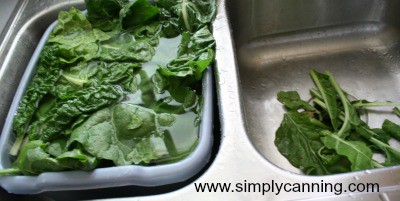
After cleaning your greens you will want to blanch them. Heat your greens in a few inches or so of water until just starting to wilt. Stir while you are heating them to get them evenly heated.
Using a blanching basket makes this easy, but you can also just use a tongs to handle the greens. When the greens are blanched dip into cold water to stop cooking and then drain well.
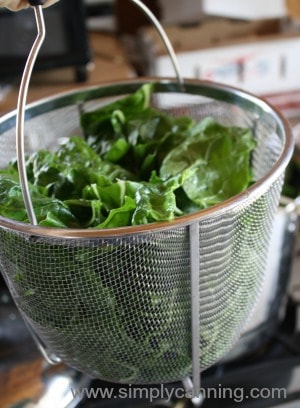
Next, you want to pack your blanched greens into jars. You can do quarts if you want… I recommend pints. Pack into hot jars leaving 1-inch headspace. Add 1/2 tsp salt to pints and 1 tsp to quarts. (salt is optional)
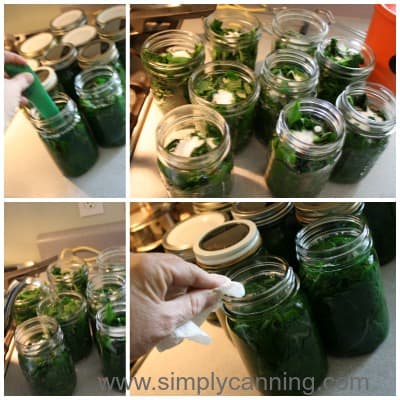
Fill jars with boiling water, again leaving 1 inch head space.
Next be sure and wipe off the rims of your jars. If there is salt or greens sticking to the jar it will interfere with the seal to the canning lid. A quick swipe with a damp paper towel is usually enough for this type of food. It is not greasy or sticky like meat or jam would be.
Place your canning lids and rings on the jar. Tighten down finger tight. Not too tight but snug is fine. Process in a pressure canner according to pressure canning instruction. If you are not familiar with how to use a pressure canner check this link. s on how to use a pressure canner.
Be sure and use the correct pressure according to your altitude as shown in the chart below. I am high altitude so I use 15 pounds. Yours may be different.
Pints need 1 hour 10 minutes
Quarts 1 hour 30 minutes
Always follow tested methods for canning. Canning processing source NCHFP canning greens
Tips and Frequently Asked Questions:
How many pounds of spinach??
Greens are light and bulky when fresh. When you blanch them to pack your jars…they shrink. A lot. You’ll need a lot of greens to make this worthwhile. And I recommend pints. A quart is a lot of greens.
I have to admit…. I didn’t really like home canned greens.
But then again I don’t think I’d like commercially canned greens either. I love fresh greens but cooked greens are not my favorite. I can manage cooked spinach but not other types of greens. So that probably affected my use.
I did this project mostly because several folks asked about canning kale and canning spinach. All greens are canned the same. I thought it would be great to have on hand in jars. So did a batch of swiss chard. Swiss chard grows well here and I always have plenty.
It is now the next spring, and I have used a grand total of……. one pint jar. All 6 other jars are still on my shelf. I just didn’t care for it. BUT, that is not to say that you wouldn’t love it! So here you go.
Liquid Loss?
A few things I noticed with this project. I had a lot of liquid loss. This is something I’ve seen repeatedly with canning greens.
To lessen liquid loss be sure you have properly vented your canner at the beginning of your processing time. This means allow steam to escape for a full 10 minutes before placing the weights on and building pressure.
Also important is to allow your jars to slowly cool down. After the canner reaches zero pressure let it rest 10 more minutes. Then open your lid and let some steam out. Set the lid back on your canner and let it rest another 5 minutes unclamped down but covered. Then take the lid off, let it rest yet another 5 minutes. THEN take your jars out, allow to cool to room temperature and check your seals.
This allows those jars to depressurize slower and resists the problem of liquid being siphoned out of your jars.
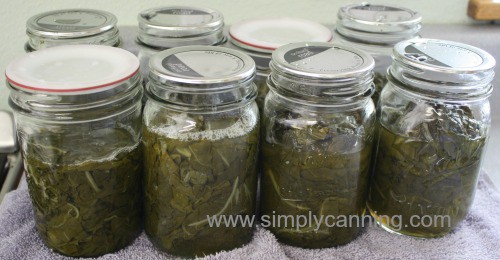
In the image above the jar on the far left is borderline ok. I placed it in the fridge and used it within a few days. Some of the other jars have some liquid loss. Not much, so they are fine. A bit unappealing but fine.
Is canning or freezing greens better?
Question from my inbox: When canning greens, do you ever cut the leaves down into smaller pieces? I grow Swiss Chard and my family loves it. I am growing more this year and am looking for ways to process it, either canning or freezing. Have you ever tried freezing greens. If so, which do you like better?
Answer: I have only canned them once just to try it and because I kept getting asked about it. It was super easy. Directions are above. When I canned these I left the pieces in fairly large sections. I did chop it but not very much, And actually, I think I would have liked it better chopped more. So my suggestion is to chop it up. In my article above I mention that I really didn’t care for greens canned very much. So I haven’t done it again. My preference is definitely freezing greens over canning.
Recipe Card Canning Greens
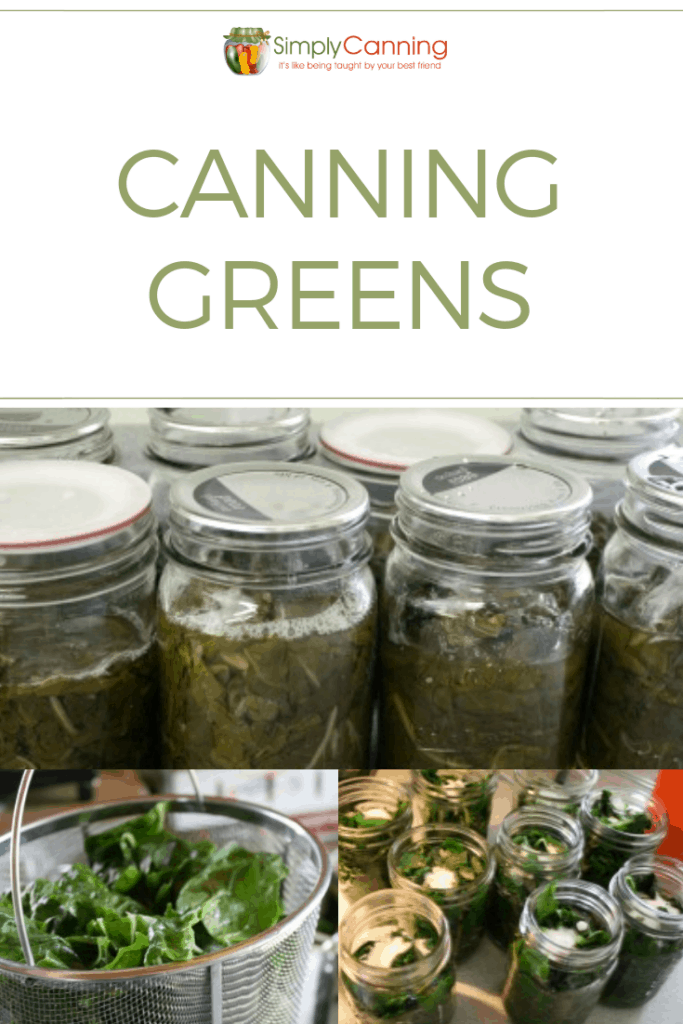
More pages you might like.
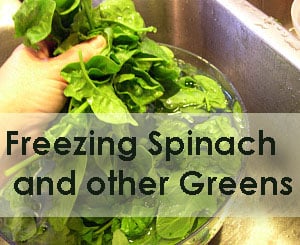
Freezing Spinach
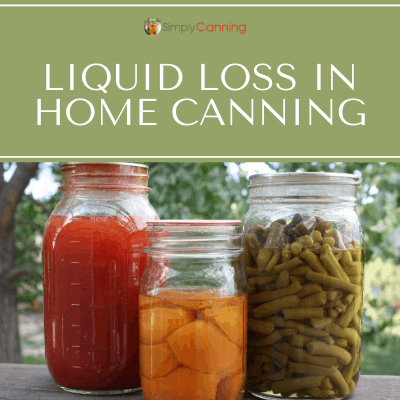

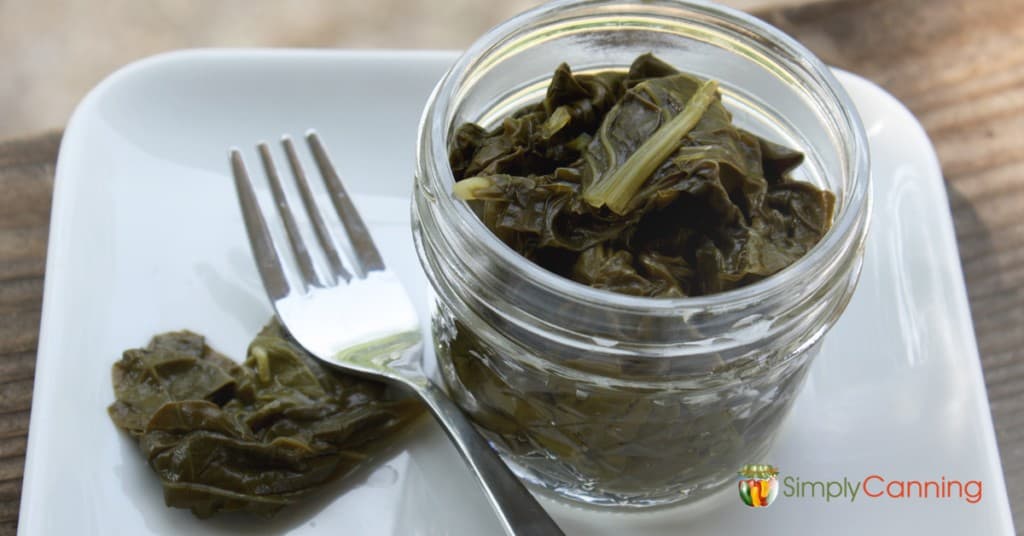

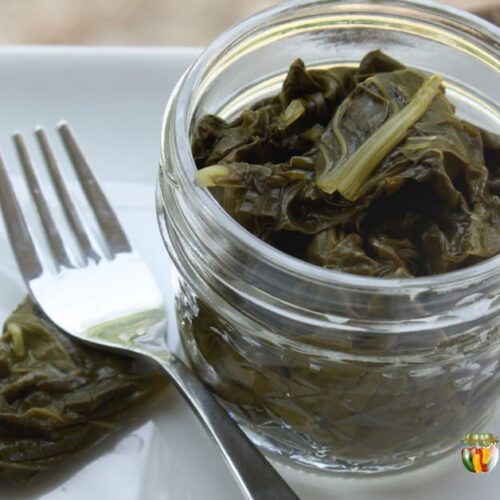
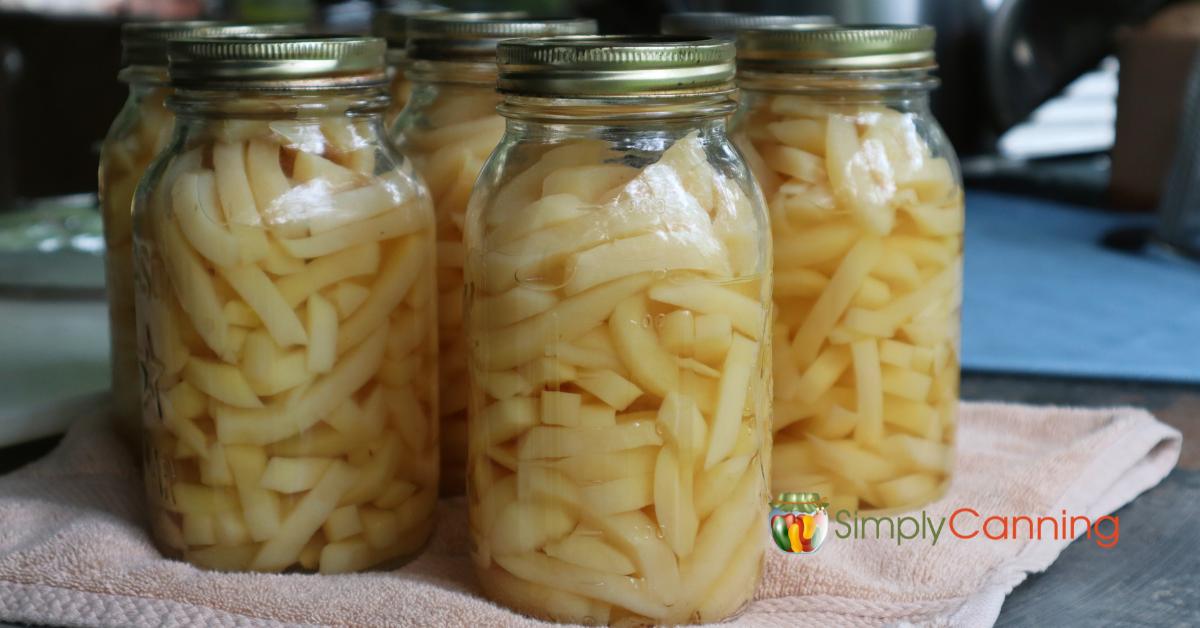
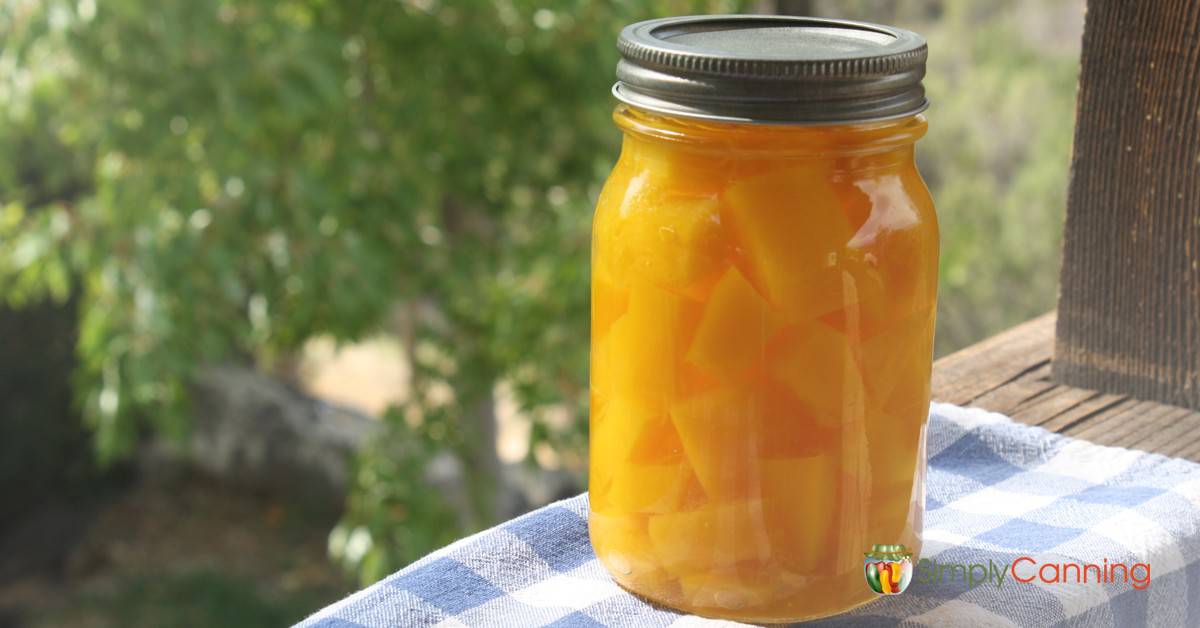
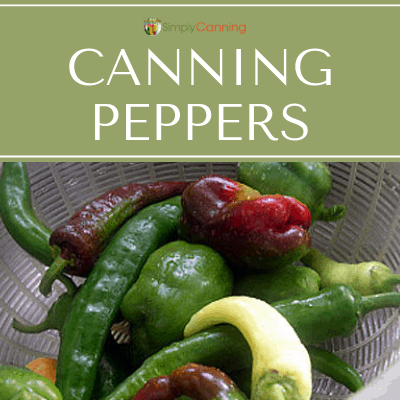
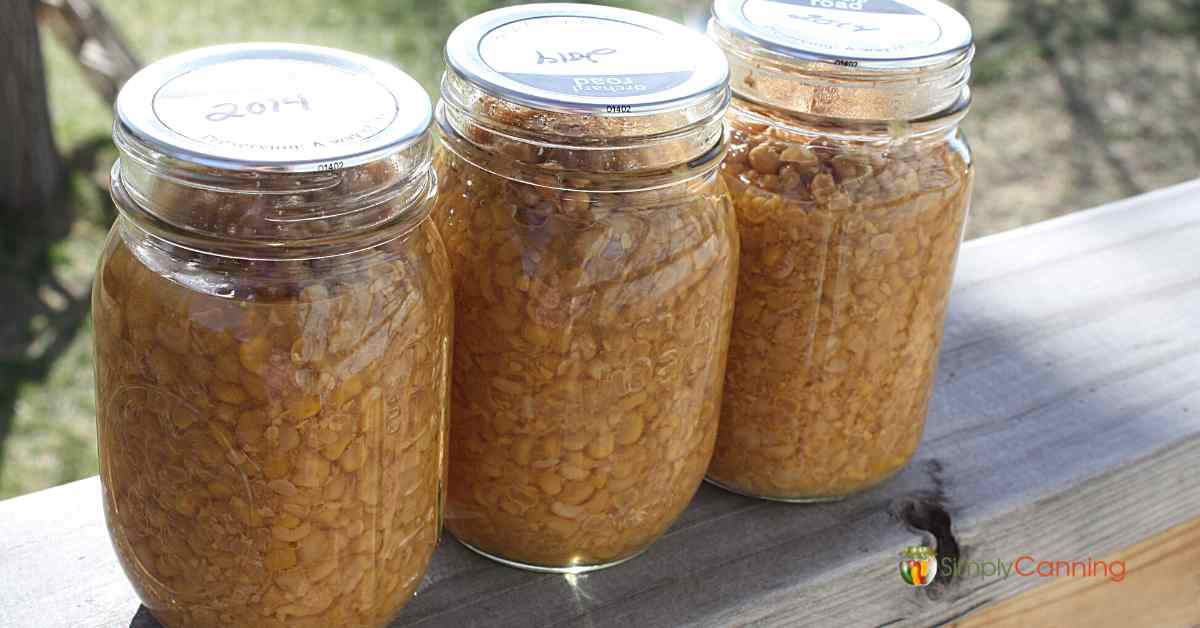
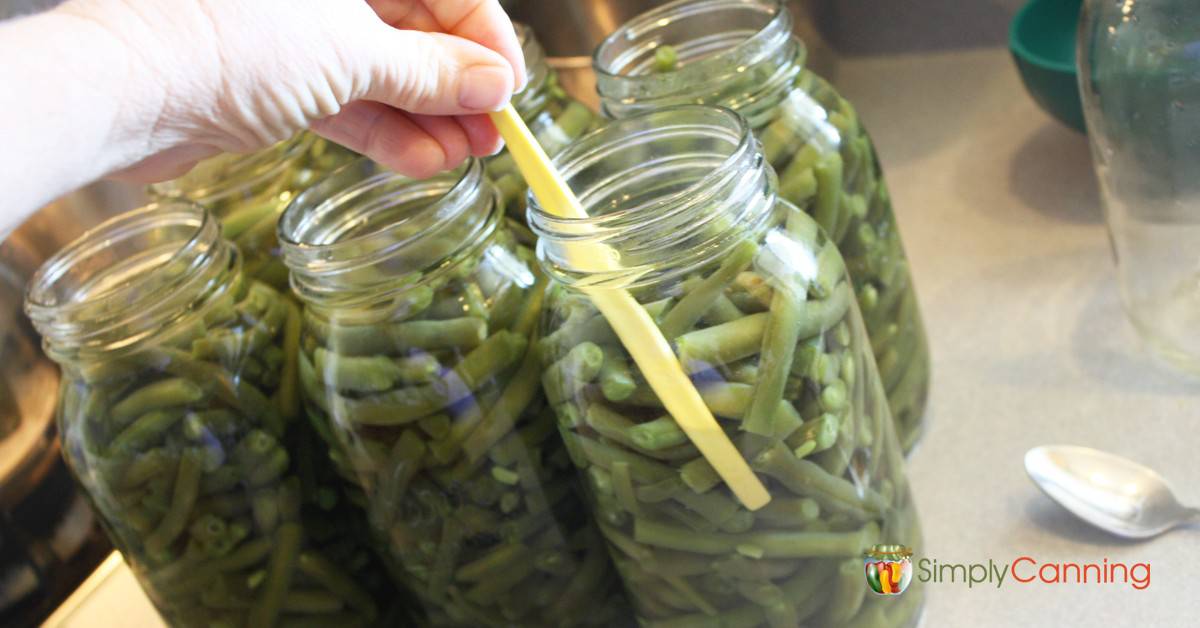
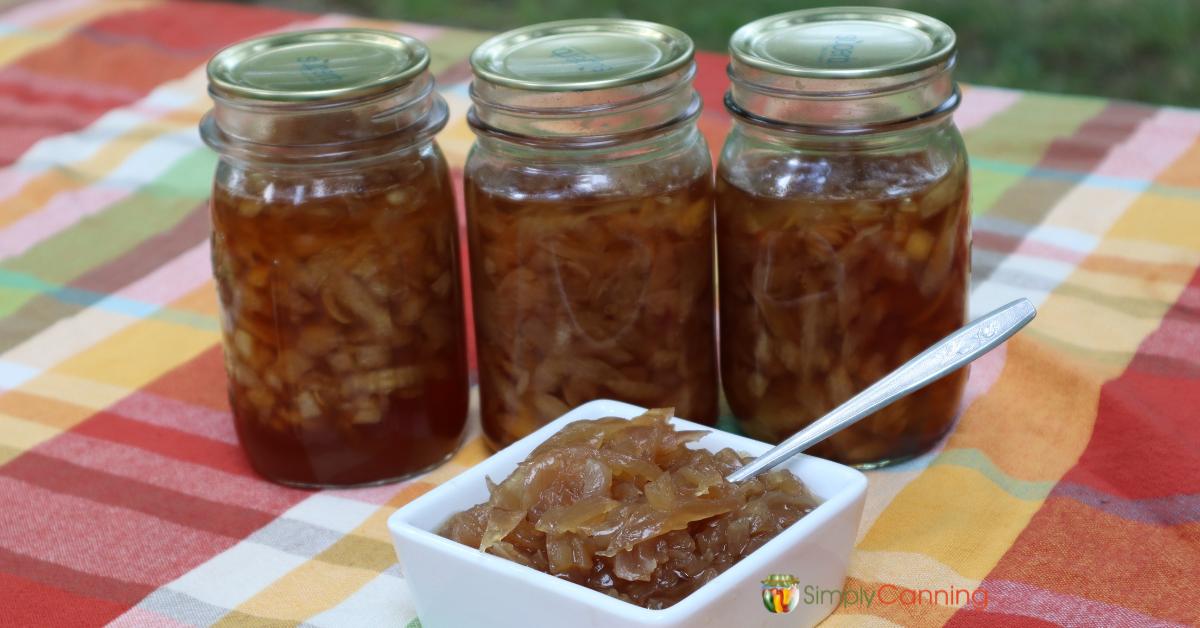
Can you waterbath greens
No, greens really must be processed in a pressure canner. YOu can read more about how to decide what canning method to use here.
Usually when I cook greens I throw smoked turkey neck in with them. Can I add the turkey meat to the jars instead? I’ve never canned greens before. It never occurred to me to do so.
No unfortunately when you add meat you totally change it up. This is not sufficiently processed for meat. But you can certainly add it when you open the jar to eat it.
May I suggest trying the greens fried in bacon fat and with onions?
Or maybe making them part of a soup like Wedding Soup?
(My first try, I can’t just let them go to waste)
So long as you mean when you open the jar to serve… fried in bacon fat with onions actually sounds pretty good. I might have to give that a try! Just so others are clear I don’t mean adding bacon fat or onions to the jar. :).
I was told by a friend of mine that she cans her mustard greens without any water in them for 90 minutes. Have you ever heard of a method of canning them like this?
Hi Rhonda, this is a new method that I’ve only seen recently. Some people call it dry canning but the term is pretty vague. I don’t recommend it. Here is a short video chat (and written article) I did regarding the topic. What is ‘dry canning?’
Can I add raw bacon to my turnip greens before processing?
No, unfortunately you can not. Bacon adds a whole new ingredient and the recipe is not written to include bacon or any other meat.
You can however add a bit of bacon when you open the jar to serve your turnip greens. Simply cook up some bacon, chop it and add to your cooked greens. I do this will green beans and bacon. I also add a bit of the bacon grease too.
I’ve never had turnip greens but I bet with bacon it is yummy! Just don’t can turnip greens with bacon.
can your use water bath method to can beet green in stead of a pressure cooker
No, Greens must be processed in a pressure canner.
I’m not a fan of canned greens as a side, but if the freezer is packed
and I just can’t fit one more bag, I don’t mind sparing some jars for the extra greens. I like to puree them and add to soups, stews and pasta/chili/mole sauces for the nutrition. I also add them to my home-made dogfood and feed them to ailing chickens/goats for an iron boost.
Ooo pureeing them to add to other things is a great idea. Something to consider when I’m thinking about whether or not to can more greens.
Hello. I have been following your blog for some time. I really have confidence in your methods and advice. I’ve never pressure canned before and just received my Presto 16qt pressure canner with a dial gauge and weight. I live @1880 ft above sea level. What pressure do I need to achieve to safely process non-acidic foods? 11 lbs, 12 lbs, 15 lbs? I’m confused!! Thank you for your time.
Hi there, Congrats! You are going to have fun! Take a look at this page. Altitude Adjustments in home canning. I think it will answer a bunch of questions for you. Since you have a dial gauge you can use 11lbs pressure as measured on the dial. The weight that comes with your canner is likely just a one-piece weight to hold in the pressure. You adjust the heat source to keep the canner at pressure. If you had a weighted gauge they have 5,10,15 pounds as options. So if your requirement is 11 you’ll go to the next poundage… Read more »
Thank you so much!! Yes, I was worried about pressures at my altitude. I did a “water test” yesterday and on the lowest heat setting, the canner maintained 16 lbs of pressure. Also, I have a smooth top Frigidare stove. The 8 inch burner fits the bottom of the canner perfectly. I know my local extension office will check dial gauges. And I’ll certainly check out the workshop!
How. Much. Water. in the canner? A few inches? Enough to cover the cans? Why is this essential info NOT in the instructions?
Hi, Martha! It’s generally something like 3 quarts, but it depends on your canner, so make sure and check the manual. 🙂 This information is linked in the recipe: https://www.simplycanning.com/pressure-canning/
-Rachel (Sharon’s assistant)
Your PC comes with instructions. Always have a minimum of 3 qts water in it.